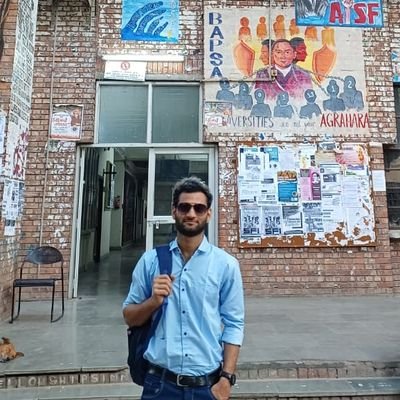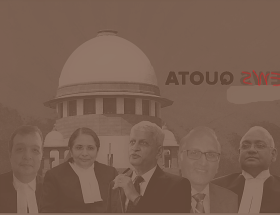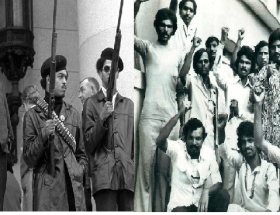Vaibhav Kharat
Recently, Rahul Gandhi’s visit to a Dalit kitchen and his interaction with the Dalit family was broadcast on his YouTube channel, which has millions of subscribers. It was framed as an act of inclusion, meant to bring attention to the everyday lives of Dalits, particularly their food culture. The visit showcased his conversations with the Sanade family and the meals they prepared together, seemingly positioning Gandhi as a figure of cultural assimilation. Yet, beneath the surface, what appears to be an empathetic gesture reflects a more profound, insidious form of casteism. Taking a leaf from Prof. Y.S. Alone’s conception of caste as psychotic perversion, I would describe this behaviour as “Savarna saviour psychosis”—a social phenomenon of hallucination where Dwij Born figures claim to help the oppressed, challenging the caste norms but, in reality, perpetuate the very structures of power they claim to challenge.
The Cynicism of Publicising Dalit Kitchens
A central issue with Gandhi’s visit is the public display of a Dalit kitchen. Shahu Patole’s words—“Dalit kya khate hain, koi nahi janta”—are invoked as a justification for this exploration, framing Dalit cuisine as something obscure and exotic. Yet, such publicization itself reeks of casteism. In Indian society, the kitchen holds symbolic significance, especially concerning notions of purity and pollution. Historically, Dalits were not allowed to enter Savarna kitchens due to the belief system that their presence would pollute the space. Gandhi’s visit reinforces this symbolism, suggesting that Dalit kitchens only become visible or noteworthy when a Savarna mediates their entry into the public gaze. If these acts are truly meant to challenge caste norms of the kitchen, then why don’t these Savarna’s showcase their kitchens, questioning their exclusionary practices? Why isn’t the accessibility of their kitchens scrutinized? Or why Rahul Gandhi didn’t go to Brahmin Savarna’s houses and publicize their pseudo-acts of sympathy and their food culture in public virtual space?
The message here is not of inclusion but of caste-based othering. Gandhi’s visit subtly conveys to Dalits that they are invisible unless a Savarna chooses to make them visible. They are impure unless a Savarna makes them pure. It tells the public that Dalit lives, kitchens, and food are only worth attention when acknowledged by a Savarna. This isn’t about breaking caste boundaries but about cementing them further, ensuring Dalit’s food culture remains dependent on Savarna validation to gain recognition.
The Politics of Recognition and Dependency
At the heart of this issue lies what I say is “Savarna saviour psychosis.” This psychosis thrives on the assumption that the oppressed requires the oppressor’s recognition to exist; as Prof. Ravikant Kisana says in his swaddle series and podcast about caste and Savarna, the Savarna thinks that ‘they are only can save and emancipate Dalits, they have the gifted power to make others live worth living’. The same, Gandhi’s visit encapsulates this notion. His presence implies that Dalits need a figure like him to draw attention to their existence, as if they remain unseen otherwise, which is his social hallucination, therefore the visit isn’t about uplifting Dalits—it’s about projecting Savarna dominance in the subtlest of ways. This dynamic can be understood through Frantz Fanon’s analysis of colonization in Black Skin, White Masks. Fanon proved how the colonized internalize the values of the colonizer, believing their worth comes from external validation. Similarly, Gandhi’s publicization of a Dalit kitchen creates a framework where Dalits are made to believe they need Savarna recognition to participate in mainstream society. It’s a form of mental colonization, where the oppressed are led to think their existence depends on the oppressor’s benevolence. As Dr. B.R. Ambedkar aptly put it in Annihilation of Caste: Caste has killed public spirit… caste has made public opinion impossible. Virtue has become caste-ridden, and morality has become caste-bound, caste is colonisation. Gandhi’s actions perpetuate this caste-bound morality by reinforcing the idea that Dalit lives are only valuable when mediated through the Savarna gaze.
Moral Exploitation and the Illusion of Kindness
One of the most troubling aspects of his visit is the moral exploitation which can be seen as an act of Kindness, this gesture serves as a display of what Friedrich Nietzsche would say is master morality or lion morality, According to Nietzsche, those in power create a morality that justifies their dominance, while the oppressed internalize a morality of submission and subjugation with a devotion which is slave morality, Gandhi’s so-called act of kindness positions him as a moral authority as if by interacting with Dalits, he is “elevating” them by entering into their kitchen. But this kindness is hollow—merely performative. The Savarna saviour psychosis functions by making the oppressed feel grateful for even the smallest gestures of sympathy, ensuring their continued subjugation. In this framework, Dalits are expected to respond with what Nietzsche might call “sheep morality”—a morality of obedience and gratitude. This dynamic echoes the tale of Sabari, the Bhil woman who devoted her Life to worshipping Lord Rama without his presence after he ate the berries she offered him. This narrative of devotion is what is implicitly demanded of Dalits when Savarna figures visit their homes, they are expected to be thankful, internalizing the idea that their worth depends on Savarna validation and acknowledgement only.
Herein lies the moral exploitation: Gandhi’s visit does not reject caste practices but propagates them by creating a scenario where Dalits are made to rely on Savarna’s approval. In a Weberian sense, how state legitimate violence or power. The same, It’s a subtle form of domination, where the oppressor maintains power by making the oppressed grateful for acts of “kindness” that only serve to legitimize the oppressor’s authority or power.
The Spectacle of Assimilation
Another problematic aspect of this visit is the spectacle of assimilation it creates. Framed as an act of assimilation and association, Gandhi’s visit gives the impression that by cooking with a Dalit family, he is breaking down caste norms of purity and pollution. But this assimilation or association is nothing more than an illusion. The French philosopher Jacques Rancière’s concept of the distribution of the sensible comes to mind here. Rancière argues that those in power control what is seen, heard, and valued in society. Similarly , Michel Foucault’s theory of biopolitics can help here. Foucault contends that power manifests not only through direct oppression but also through the regulation of visibility—who gets seen and how. By framing his visit as inclusive, Gandhi is not aligning himself with Dalits; he is controlling the narrative around them.
Dalits should not have to rely on a Savarna figure to make their lives visible. But Gandhi’s visit creates a situation where Dalits become visible only through his actions, which reinforces caste-based paternalism and identification rather than challenging it.
The Politics of Caste and Food
Gandhi’s act of showing the Dalits ‘I can share values with you so we will have similarities is a facade because food in India has caste-based symbolism. Sharing food, cooking together, and eating together or from the same plate are all acts imbued with deep social and personal meaning. Given the historical exclusion of Dalits from these acts with Savarna’s, Gandhi’s visit might seem radical. However, instead of breaking down food norms, Gandhi’s public visit politicizes Dalit food culture against the backdrop of Maharashtra’s political climate, reducing it to a tool for electoral gains for state assembly elections. Historically and culturally Dalits and Savarna are never part of each other kitchens, and even today, the idea of sharing food across caste lines carries weight. The power dynamics remain intact; hence, Savarna figures control the narrative. The act of sharing food thus becomes less about assimilation and more about legitimizing Savarna’s dominance through cultural appropriation in the end, which leads to institutional cultural hegemony.
The Danger of the Savarna Saviour
The most dangerous aspect of this “Savarna saviour psychosis” is the illusion or hallucination of progress it creates while maintaining the structures of caste. By visiting a Dalit kitchen and publicizing it, Gandhi is positioning himself as a saviour, as someone who is helping Dalits become visible and recognized. It’s directly or indirectly telling all Dalits, “See, I’m here to listen to you because you’re Dalit and oppressed because no one comes to your house, because no one enters your kitchen, because no one cooks with you because no one shares meals. I’m here, and you have to depend on me for your identity, your consciousness, your recognition, your acceptance, assimilation, even assertion and entire acculturation. Without me, you don’t have a sense of self. It’s always me, the Savarna, who gives you the ability to be yourself. Your participation in mainstream society will only be taken seriously when I (the Savarna) permit you to exist. And this act will prove that you are bound to me, that you are obliged to me” That’s why Dalits should refute and rebel against this act of dependent approval of Savarna by Savarna.
In reality, Dalit liberation will not come through the hands of Savarna saviour’s sympathy but will come through when Dalits assert their identity, their culture, and their worth without the need for Savarna intervention. As Ambedkar pointed out, “The caste system is not merely a division of labour. It is also a division of labourers.” Gandhi’s visit does not disrupt this division; it reinforces it by reminding Dalits that their visibility and recognition depend on Savarna’s validation. Gandhi’s act would have been truly appreciated if, instead of merely visiting a Dalit kitchen, he had invited Dalits into his own home, welcomed them into his kitchen, and cooked alongside them, sharing the same meal from the same plate and upload on his YouTube channel. So True assimilation will not emerge from Savarna saviours but from the dismantling of the very structures of caste that make such saviours necessary.
~
Vaibhav Kharat is a Navayanist, and a postgraduate in Sociology from CSSS, JNU. He can be contacted at vaibhavkharat210@gmail.com
~~~










